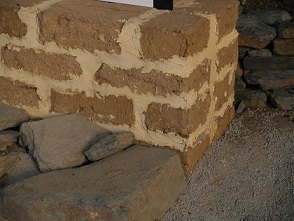
Learn Earth Building
- Learn how to make a mud brick
- See how mud bricks can be combined to create garden walls, houses, and more
- Discover a whole range of other building techniques with earth.
COURSE STRUCTURE
Mud Brick Construction aims to develop an understanding of how to approach building with mud bricks. Mud brick building is also known by the alternative name 'adobe'. There are other ways of building with mud brick apart from 'adobe'. These will be covered briefly in this course. For the novice, there is not a lot which can go wrong if you choose to build with mud brick.
The content of each of the ten lessons is outlined below:-
1. Scope of Mud Brick - Covers history and types of earth building and construction. Also involves analysis of your soil with respect to suitability for mud bricks.
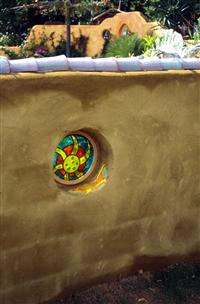 2. How to make a mud brick - You will get to make a mud brick mould; test your soil, classify it, and check it for ability to withstand compression. You will also be expected to assess other soil types and their suitability for mud bricks.
2. How to make a mud brick - You will get to make a mud brick mould; test your soil, classify it, and check it for ability to withstand compression. You will also be expected to assess other soil types and their suitability for mud bricks.
3. Planning and Site Works - Selecting a home site, designing a house to maximise energy efficiency. Introduction to building biology (ie. healthy buildings).
4. Legal Considerations - Permits, specifications etc
5. Foundations - Strip foundations, slabs, earth floors.
6. Laying Bricks - Step by step procedure, strengthening/reinforcing walls, load bearing compared with non load bearing walls, rendering finished surfaces.
7. Doors, Windows, and Roofs - Roofing methods, fixing doors & windows, general fixing, joinery, plugs etc.
8. Finishes - Alternative wall and floor finishes.
9. Services - Electricity, gas, water etc. Designing & costing a small building (eg. store or workshop).
10. Other types of Earth Building - Wattle & daub, rammed earth, cob.
AIMS
- Discuss the nature and scope of Mud Brick construction
- Identify the legal considerations which need to be met when building in mud.
- Determine the requirement for foundations for a mud construction.
- Determine options for building doors, windows and roofs into a mud building
- Analyze options for coating or finishing the surface of a mud wall or other mud construction.
- Compare options for providing water, electricity or any other required services in a mud building.
- Describe a variety of mud construction techniques other than mud brick.
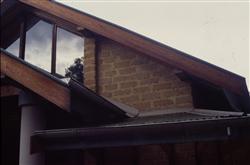
EXAMPLES OF WHAT YOU MAY DO IN THIS COURSE
- Get together a sample of earth which you might like to use to make mud bricks. This earth might be on a property where you wish to build a mud brick house, or it might be from a friend's property. Collect earth from at least a few inches below the soil.
- Find different types of soil. Give your assessment on the suitability of each for making mud bricks. Send a sample of each soil type along with your assessment of it's suitability for making mud bricks.
- Using different types of soil make test mud bricks. One mud brick should be made with each type of soil plus straw. Make another brick out of each type of soil without straw.
- Visit or contact your local council's building department. Find out from them where you can obtain a copy of `Standard Specifications' from.
- Explain step by step how you would go about putting down a concrete strip foundation for a small single level mud brick workshop.
Duration: 100 hours (study at your own pace, the average time to complete this course is 5-7 months)
Will Mud Brick Suit You?
Earth building has been, and continues to be, a traditional form of construction in dry climates such as the Middle East, parts of Asia, and North Africa. If rainfall is low, mud buildings are not going to deteriorate so readily; and less effort may be required for repairs.
Earth buildings can, and are, nevertheless, still successful in wet climates, where the eroding effect of rain can be controlled by either:
- Putting a waterproof coating over the earthy wall (eg. bondcrete -a plastic/glue like substance)
- Impregnating the mud with a water resisting material during construction (e.g. Cement or a plastic type material)
- Capping walls with an overhanging top (e.g. wide eaves on a building, concrete tiles or stone slabs on top of walls, etc).
Building laws will also vary from place to place around the world. In some places, mud brick construction may even be illegal; or if not, heavily regulated. In other places, mud construction is no more restricted than any other form of construction.
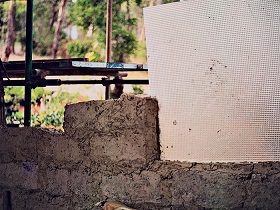 What Type of Soil Do You Need for Mud Bricks?
What Type of Soil Do You Need for Mud Bricks?
The best soils for mud bricks would be 'clays', 'clay loams', 'silty clay loams', or 'silty clays'. Sandy clay loam would require additional clay and or organic matter added (e.g. straw) to make an effective brick mixture.
One way of determining the type of soil you are dealing with is to ask someone who knows about soils. Anyone who has studied soils should be able to tell you what type of soil you have. You may need to consult someone such as a Soil scientist, Engineer, Surveyor, Irrigation Expert, Horticulturist, Agriculture teacher, Geologist or Mining Engineer. Soil testing laboratories that exist in most large cities, could be useful for getting a more precise and detailed description of a soil: and these are sometimes used as a matter of course by engineers and even builders, in order to understand what is required for a building’s foundation (apart from whether the soil is appropriate for use in making mud bricks).
A simple way you can go about determining what a particular type of soil is:
- Place a small quantity of soil in the palm of your hand and add just enough water to make it plastic. If it doesn't stain the fingers, doesn't bind together and is gritty to feel, it is sand
- If it doesn't stain the fingers but can be rolled into a ball which barely adheres together, then it is loamy sand
- If it forms a more solid ball which can be rolled into a cylinder, but breaks when the cylinder is bent, and if it still feels gritty; it is a sandy loam
- If when the cylinder is bent gently, it doesn't break and if there is no feeling of grittiness, silkiness or stickiness; then it is a loam
- If it is similar to a loam but there is a silky feeling, and if it cannot be polished by rubbing; then it is a silty loam
- If the silky feeling is very strong, but otherwise it is like a silty loam, it is silt
- If it is like a loam, but is sticky and can be polished, it is a clay loam
- If it shows the characteristics of a clay loam, but when squeezed, also has a gritty feeling, it is a sandy clay loam
- If instead of being gritty, it is silky but otherwise like a clay loam, it's a silty clay loam
- If the characteristic of stickiness is stronger than anything else, then it is clay.
- Organic soils are ones which have a large proportion of organic matter (25% or more). These are usually black or brown in colour and feel silky. It is possible to get organic types of all of the above soils.
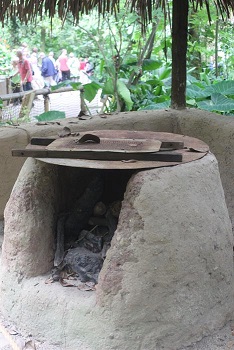
How will this course benefit you?
- You will learn to build a cheap form of construction material
- Understand how mud bricks can be used in various applications
- The best materials for building mud bricks